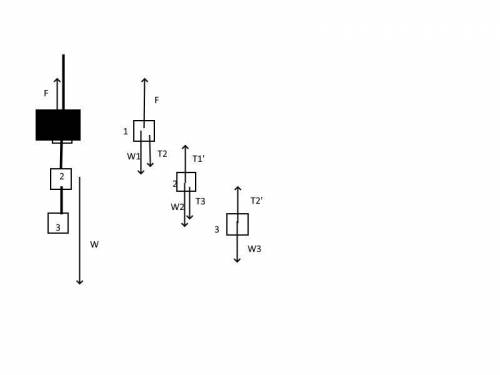
Physics, 28.02.2021 16:50 xandraeden32
A student suspends a chain consisting of three links, each of mass m 0.250 kg, from a light rope. The rope is attached to the top link of the chain, which does not swing. She pulls upward on the rope, so that the rope applies an upward force of 9.00 N to the chain.
a. Draw a free-body diagram for the entire chain, considered as a body, and one for each of the three links. (b) Use the diagrams of part (a) and Newton's laws to find (i) the acceleration of the chain, (ii) the force exerted by the
top link on the middle link, and (iii) the force exerted by the middle link on the bottom link. Treat the rope as massless.
1. There are four objects of interest in this problem: the chain as a whole and the three individual links. For each of these four objects, make a list of the external forces that act on it. Besides the force of gravity, your list should include only forces exerted by other objects that touch the object in question.
2. Some of the forces in your lists form actionâreaction pairs (one pair is the force of the top link on the middle link and the force of the middle link on the top link). Identify all such pairs.
3. Use your lists to help you draw a free-body diagram for each of the four objects. Choose the coordinate axes.
4. use your lists to decide how many unknowns there are in this problem. Which of these are target variables?
EXECUTE
5. Write a Newton's second law equation for each of the four objects, and write a Newton's third law equation for each actionâreaction pair. You should have at least as many equations as there are unknowns (see step 4). Do you?
6. Solve the equations for the target variables.
EVALUATE
7. You can check your results by substituting them back into the equations from step 6. This is especially important to do if you ended up with more equations in step 5 than you used in step 6.
8. Rank the force of the rope on the chain, the force of the top link on the middle link, and the force of the middle link on the bottom link in order from smallest to largest magnitude. Does this ranking make sense? Explain.
9. Repeat the problem for the case in which the upward force that the rope exerts on the chain is only 7.35 N. Is the ranking in step 8 the same? Does this make sense?

Answers: 1


Other questions on the subject: Physics

Physics, 22.06.2019 13:00, mandilynn22
Nacidified solution was electrolyzed using copper electrodes. a constant current of 1.18 a caused the anode to lose 0.584 g after 1.52 ✕ 103 s. given that the charge of an electron is 1.6022 ✕ 10−19 c, calculate avogadro's number. assume that copper is oxidized to cu2+ ions.
Answers: 1

Physics, 22.06.2019 15:30, haileyjones732
Two pans of a balance are 24.1 cm apart. the fulcrum of the balance has been shifted 1.33 cm away from the center by a dishonest shopkeeper. by what percentage is the true weight of the goods being marked up by the shopkeeper? assume the balance has negligible mass. answer in units of %.
Answers: 1

Physics, 22.06.2019 18:30, kennettahughley7964
Daughter element the new element produced along with a decay particle in a nuclear transmutation 2. half-life the substance that decays in a nuclear transmutation 3. parent element the change of one chemical element into another by nuclear decay or radioactive bombardment 4. transmutation the time required for the decay of one-half of the atoms in a sample of radioactive material
Answers: 2

Physics, 22.06.2019 19:00, Geo777
Abatter hits a 0.140-kg baseball that was approaching him at 30 m/s and, as a result, the ball leaves the bat at 40 m/s in the reverse of its original direction. the ball remains in contact with the bat for 2.0 ms. what is the magnitude of the average force exerted by the bat on the ball?
Answers: 1
You know the right answer?
A student suspends a chain consisting of three links, each of mass m 0.250 kg, from a light rope. Th...
Questions in other subjects:



Chemistry, 15.07.2020 01:01








 - g (1)
- g (1)



